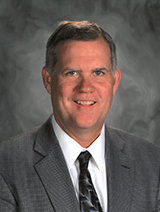President’s Perspective: Connecting on Pre-K-3
By Mark White Communicator December 2014, Volume 38, Issue 4
By Mark White
Communicator
December 2014, Volume 38, Issue 4
 What I have enjoyed the most about serving as NAESP President is meeting principals from around the nation. Our conversations invariably turn to their most pressing issues, with three continually rising to the top: student assessment, teacher and principal evaluation, and curriculum standards. These three areas of principal practice are dominating discussions, but each state’s concerns have a different twist. I have witnessed principals collaborating to use best practices to influence and implement state policies. Working together with their national and state organizations, principals are making the most of these challenges. For example, schools are welcoming younger learners than in the past, and principals are proving that they will do whatever it takes to smooth their path.
What I have enjoyed the most about serving as NAESP President is meeting principals from around the nation. Our conversations invariably turn to their most pressing issues, with three continually rising to the top: student assessment, teacher and principal evaluation, and curriculum standards. These three areas of principal practice are dominating discussions, but each state’s concerns have a different twist. I have witnessed principals collaborating to use best practices to influence and implement state policies. Working together with their national and state organizations, principals are making the most of these challenges. For example, schools are welcoming younger learners than in the past, and principals are proving that they will do whatever it takes to smooth their path.
Aligning Pre-K-3 Education
Although principals are charged with providing aligned learning for pre-K through third grade, they often have had limited training in early childhood education. That was my experience. I am now in charge of our district’s 4-year-old program, in addition to my work as a building principal. It was my choice to take on this role, and I love the challenge of guiding our youngest learners. But my practice would have benefited from additional training in aligning early learning. Principals can learn on the job, but we need support to do so.
NAESP has been working on this very issue. Last year, the Association put together a tremendously talented team to revise its Leading Learning Communities series of standards for principals. I was fortunate to co-chair the committee—along with NAESP Past President Nancy Flatt Meador—that was charged with reworking the first in the series, Leading Pre-K-3 Learning Communities: Competencies for Effective Principal Practice. I want to thank the committee, which was comprised of NAESP members from each zone with early childhood expertise, for their invaluable contributions. (See below for list of committee members).
Leading Pre-K-3 Learning Communities is a practical standards guidebook for principals. The new standards describe competencies that are grounded in the knowledge that some of the most critical years of a child’s lifetime is from age 3 to age 8—or pre-K-3. The document is divided into six competencies, and includes a spotlight of effective practice for each. The six competencies are:
- Embrace the pre-K-3 early learning continuum;
- Ensure developmentally appropriate teaching;
- Provide personalized learning environments;
- Use multiple measures of assessment to guide student learning growth;
- Build professional capacity across the learning community; and
- Make schools a hub of pre-K-3 learning for families and communities.
NAESP is using Leading Pre-K-3 Learning Communities to assist in promoting its pre-K-3 agenda, which includes demonstrating the financial and lifelong benefits of preschool; providing full-day, 5-year-old kindergarten programming and universal access to high-quality, pre-K programs; establishing standards of practice for educators working in pre-K-3 learning systems; investing in principal preparation programs that help those entering the profession understand how to create a seamless continuum of learning from pre-K to grade 3; and allocating resources to provide principals with job-embedded professional learning and growth.
A number of principals and state associations have already begun to use the competencies to help guide principal leadership with their youngest learners. I recommend that all principals use this document to strengthen their practice in aligning pre-K-3 education.
Connecting Online
If you haven’t done so already, I want to encourage you to join Twitter. Although I am relatively new to social media started my own account this year, I am amazed by the powerful professional development I have received through it already. The reflections, examples, articles, and resources that are posted there are invaluable. You can get started by following @naesp and a few principals, and then expand from there. Here is a recent article from Principal magazine that provides steps for becoming a connected educator and getting started with social media.
As you continue down your leadership journey—with both pre-K alignment and new forms of professional development, like Twitter—I encourage you to consider this quote about learning by legendary futurist Alvin Toffler: “The illiterate of the 21st century will not be those who cannot read and write, but those who cannot learn, unlearn, and relearn.” I’m inspired by your dedication to modeling this approach, and thereby instilling it in the learning communities that you lead.
I hope that each of you enjoy a wonderful holiday season!
Mark White is president of NAESP and principal of Hintgen Elementary School in La Crosse, Wisconsin.
NAESP Pre-K-3 Committee Co-Chairs: NAESP President Mark White Deborah Emery (Zone 1) Anne Corley-Hand (Zone 2) Dean Warrenfeltz (Zone 3) Kimbrelle Lewis (Zone 4) Kathryn Raasch (Zone 5) Michael Budisch (Zone 6) Jeff Ellsworth (Zone 7) Julie Bloss (Zone 8) Cathy Conger Ed.D. (Zone 9) Regina Birdsell Jon Millerhagen |
—
Copyright © 2014. National Association of Elementary School Principals. No part of the articles in NAESP magazines, newsletters, or website may be reproduced in any medium without the permission of the National Association of Elementary School Principals. For more information, view NAESP’s reprint policy

